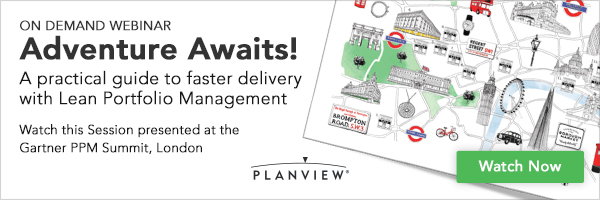
The end of the traditional Project Portfolio Management (PPM) world is near. It has been predicted that agile programs and product management will replace project management as the dominant approach for effective enterprise change and outcomes by 2023. Further, 80 percent of organizations will have an enterprise PMO focused on integrating products and programs in the same timeframe. Adopting Lean Portfolio Management can be the key to increasing agility, meeting new demands, and becoming a PMO for an agile enterprise. But how do you get there?
With these changes expected to happen in less than five years, you need to be prepared. If you’re like most people, you’re probably thinking about the changes you will need to implement within your own organization. With no standard methodology or handbook, we are all trying to figure it out. That’s the beauty and premise of the agile fast-paced world.
To get you started in the right direction, we’ve outlined three steps to adopting Lean Portfolio Management and achieving faster delivery.
Three steps to become an agile enterprise with Lean Portfolio Management (LPM)
Before we jump into the first step, let’s take a look at what LPM really is.
What is Lean Portfolio Management? It consists of five key elements:
- Value Stream Funding: Move from funding projects to funding the outcomes of a product roadmap.
- Lean Demand Management: Break work into smaller pieces with lean business cases collecting just enough information to determine if the hypothesis is worth testing.
- Iterative Planning: Fund in smaller increments, demonstrate value sooner, and go back to request additional money for other phases.
- Capacity planning: Allocate teams and shared resources to products and managed dependencies.
- Lean Governance: Streamline oversight and approvals, be adaptive and continue to improve and find efficiencies.
Now, how do you go about becoming a PMO for the agile enterprise?
1. Make the business case for change.
What are you trying to accomplish and how are you going to get there? As you search for the right approach that will lead to your expected outcome, identify your fundamental goals around:
- Predictability – To meet demand, you must make and meet commitments.
- Quality – Decrease defects and technical debt to increase customer trust and manage software products and services easier.
- Cost Savings – Prioritize investments by involving the right team so resources are focused on high-value solutions.
- Early Return on Investments – Introduce products to the market in smaller increments and charge for them sooner for faster value realization.
- Product Fit – Deliver products in smaller batches and gather frequent customer feedback to quickly change direction to meet changing customer requirements.
- Innovation – Inform teams and communicate context to the organization so market uncertainties can be exploited.
The expected outcomes will form the strategy your organization will use to build teams, backlog and produce products and services.
2. Bridge strategy to delivery.
In this everchanging world, connecting strategy to delivery is more complex than ever. Agility—what you should strive for—boils down to two key things.
- Ability to gather feedback and react so that you can deliver faster
- Results are important versus activities or deliverables
As agile grows and scales beyond a few delivery teams, there will come a time when it cannot connect using traditional portfolio management practices. Traditional portfolio funding models require a long horizon from the business case with detailed cost estimates through work being done, output delivered and benefits being realized.
Agile teams don’t use detailed cost estimates because they deliver incrementally and make changes more often. Instead, they use feedback loops to plan and make changes based on what customers want. With this approach, it’s almost impossible to predict the team’s deliverables. However, it is critical that they build the right things. This creates a gap between strategy and delivery, due to:
- Lack of visibility from portfolio to teams
- Inflexible annual planning and funding cadence
- Inability to show value delivered against strategic objectives
- Difficultly adjusting priorities based on evolving market conditions and customer feedback
This creates tension among executives, the PMO, and delivery teams.
A new approach is needed to bridge strategy to delivery. That approach is to apply lean principles of eliminating wastes, optimizing build quality in, respecting people, and the practice of build, measure, and learn to the funding process. By using a more iterative approach with Lean Portfolio Management, you’ll use strategic planning to define objectives and outcomes and use high-level funding against value streams or products versus projects.
3. Set the course
Before creating the plan that leads you to your final destination, you must understand where you are today and where you want to be moving forward. Always be open about the impediments that will make the journey difficult.
Identify processes you can do today and processes you want to do in the future. Next, determine the people, processes, and tools needed to fund products or value streams. For your plan to become a reality, document processes. Plan, communicate your plans and processes, and then re-plan as needed. By following this journey map, you will gain the trust of your team and customers and overcome technical constraints. Seek continuous feedback and refine processes and plans based on that feedback.
Remember, people in organizations are resistant to change. You as a PMO leader are the change agent. Focus on the desired outcomes so you can impact what matters most to the organization. Reduce identified wastes in the processes and governance. Finally, increase responsiveness to change, the value of the journey and the goal of agility. When you take advantage of these steps, you’ll quickly see the results of how building agility with Lean Portfolio Management benefits the achieved results.
To learn more, be sure to check out the popular 15-minute Theater Session that was presented at the Gartner PPM Summit, “A Practical Guide to Faster Delivery with Lean Portfolio Management.”






